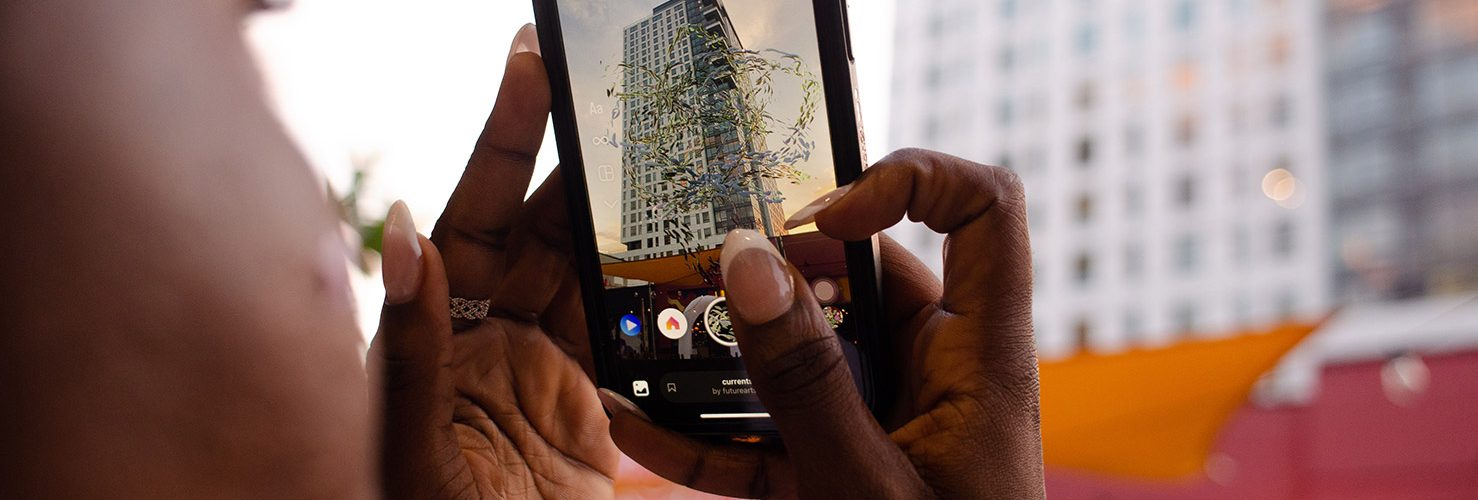“Nature as Queen”: An Embodied Philosophy
The cohesive force that stitched AUGMENT together was the showcase’s theme, “The New Nature.” Future Arts saw the necessity to have dialogue around how humanity can stay rooted in Source and the earth, while simultaneously embracing technological advancement.
“I think [COVID-19] was like a baseline reality shift for all of us…” says Bruk. “Everyone was kind of flailing and trying to figure out: what is that new normal? How do we connect in a more authentic way through technology?”
When it became safe for in-person events again, Future Arts saw an opportunity to incorporate the senses that society lost in isolation with interactive technologies, all while making a space that was accessible to multigenerational and multicultural audiences.
“I always say my goal is to have my family come out and ‘get’ it…” says Bruk, who comes from a family of non-native English-speaking immigrants and refugees. They also have a brother with an intellectual disability and found that growing up, very few places were inclusive of him. “I want to create a space where my family is welcome, and [where] I’m not afraid to bring [them] to that space.”
With the awareness that technology can pose many barriers for a variety of different reasons, Future Arts was intentional about making a free, publicly-accessible event. They also loaned out phones, made portable chargers available, and offered multiple tours in English and in American Sign Language, to introduce the artworks and instruct people on how to navigate the medium of AR.

“Ancestral Future: Indigenized Landscapes” by Gabriel-Bello Diaz and Yes Segura. (LEFT) Credit: Yabsira Wolde (RIGHT) Credit: Katharina Brinschwitz
“Ancestral Future: Indigenized Landscapes,” by Seattle-based artists and community organizers Gabriel-Bello Diaz and Yes Segura, featured an augmented reality art mural, where digitized plants Indigenous to the Puget Sound region grew out of the exterior walls of a bar and spa on 9th Avenue. A voiceover by Melissa (BONI) Young (Tulalip), played through participants’ phones, reciting in the Lushootseed language the traditional names of three local plants: stəgʷəadac (Salmonberry), c̓əx̌ʷədac (Indian Plum), and xʷəlčƛ̕ (Wild Ginger).
Being able to walk amongst — and through! — three-dimensional, large-scale native plants, while listening to the ancestral names given to them by the First Peoples of the land, reminded viewers of the plant relatives that once grew abundant beneath the cement and of the Coast Salish people who cared and continue to care for them.
Across the street, people gazed up and pointed their phones at seemingly empty space. “currents,” by Russianf urban designer and digital artist Alina Nazmeeva and Portland ecologist Alex Kosnett, intentionally used AR to superimpose a holographic salmon run in place of a construction site where a new high-rise will emerge in the coming months. Swirling “currents” of salmon, flowing in an infinite loop, helped stretch imaginations and visualized a future where flying fish signaled the coming change of the city’s landscape. “currents” worked to simultaneously mourn space soon to be forever altered while celebrating the unique role of salmon and other fish in the broader ecosystem of the Salish Sea.
- Introduction
- Augmented Reality as Everyday Reality
- “Nature as Queen”: An Embodied Philosophy
- The Body as Glitched Out Form
- Community Needs Brought to Life
- Data Strategies for Unbiased Curation
- Future Visions for Future Arts






